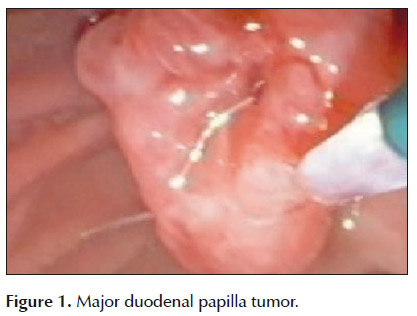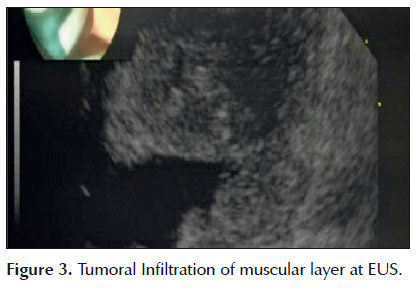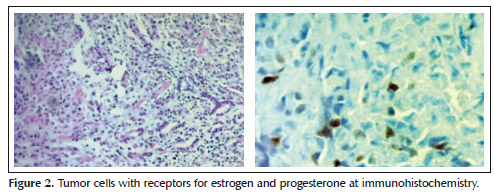Servicios Personalizados
Revista
Articulo
Indicadores
-
 Citado por SciELO
Citado por SciELO
Links relacionados
-
 Similares en
SciELO
Similares en
SciELO
Compartir
Revista de Gastroenterología del Perú
versión impresa ISSN 1022-5129
Rev. gastroenterol. Perú vol.34 no.2 Lima abr. 2014
Reporte de casos
Metastasis of breast cancer to major duodenal papilla
Tiago Bastos1a, Thiago F. Souza1a, Jose P. Otoch2a, Eduardo Grecco1a, Fabio Àvila1b, Everson L.A. Artifon1a
1 Department of Gastrointestinal Endoscopy, Faculty of Medicine of ABC. São Paulo, Brasil.
2 Department of General Surgery, Faculty of Medicine of ABC. São Paulo, Brasil.
a Physician Assistant b Resident
ABSTRACT
Metastasis is an infrequent cause of tumor involvement of the major duodenal papilla and of cholestasis. We report a case of obstructive jaundice due to a metastatic breast carcinoma to the major duodenal papilla, and assess curative and palliative treatment that interventional endoscopy can offer.
Key words: Ampulla of Vater; Breast neoplasms; Jaundice (source: MeSH NLM).
RESUMEN
La metástasis es una causa infrecuente de compromiso de la papila mayor y colestasis. Reportamos una causa rara de ictericia causada por metástasis de cáncer de mama en la papilla mayor duodenal.
Palabras clave: Ampolla de Vater; Neoplasias de la mama; Ictericia (fuente: DeCS BIREME).
INTRODUCTION
Approximately 30% of patients with breast cancer will develop metastasis; each histological type (intraductal or lobular) has a predilection for different organs.
In lobular carcinomas, metastasis usually involves the bone, but only in 15% of the cases, other sites are observed, such as gastrointestinal organs (1,2). In these cases, the metastases occur primarily in the colon (42%), stomach (37%) and small intestine (16%), with rare metastases to the juxtapapillary region (1,3).
In this report we present a case of biliary obstruction due to metastatic breast cancer to the major duodenal papilla.
CASE REPORT
63-year-old patient caucasian female, with invasive lobular breast carcinoma was diagnosed in December 2010. The patient underwent a modified mastectomy and adjuvant chemotherapy for bone metastases to the lumbar spine in December 2011.
In August 2012 the patient presented abdominal pain and cholestasis syndrome. The laboratory evaluation revealed bilirubin totals 7.94 mg/dl, direct bilirubin 7.0 mg/dl, alkaline phosphatase 500 u/l and gamma glutamyltransferase 781 U/L. Associated with such findings, a 15 mm dilatation of the intra and extrahepatic biliary tree was observed by abdominal ultrasound.
The patient underwent an endoscopic retrograde cholangiopancreatography (ERCP), where a swollen, friable and bleeding papilla was found, with necrotic areas. Dilation of the intra and extrahepatic bile duct (15 mm) was noticed. A papillotomy was performed and a 10 French x 9 cm plastic stent was placed in the common bile duct. Figura 1.

Histological examination showed a carcinoma, with infiltration in the duodenal mucosa. The immunohistochemical study of the tissue biopsy proved to be strongly positive to estrogen receptors (100%) and progesterone receptors (20%), confirming metastasis of the lobular breast carcinoma to the major duodenal papilla. Figura 2.
An endoscopic ultrasound (EUS) was recommended, and it demonstrated infiltration of the injury until the muscular layer of the duodenal wall, without suspicious regional lymph nodes. Figura 3.

Due to the invasive nature of the lesion, palliative treatment was offered with replacement of the plastic stent for a metallic one the patient had significant improvement of the cholestatic syndrome and abdominal pain.
DISCUSSION
Malignant neoplasms affecting the major duodenal papilla are rare, and the adenocarcinoma is the histological type in almost all cases, but occasionally other histological types such as carcinoid tumors, squamous cell and mucinous carcinomas can be found (4). Within this context, the metastases of breast tumor to the major duodenal papilla are a very rare event, with only three cases reported in the world literature, all due to lobular breast carcinoma.
The sensitivity of the histopathological diagnosis depends on the appearance of the tumor, 88% for ulcerated tumors, 64% for the vegetative type and 50% for intramural tumors (4-6).
Immunohistochemistry plays a key role for indicating the histological type of the tumor, since the metastases of lobular breast carcinoma to the gastrointestinal tract have an endoscopic, radiological and histological aspect similar to the adenocarcinoma poorly differentiated with signet ring cells. Therefore, it is very important to differentiate these kinds of malignancies, since each of them has a different prognosis and treatment (3).
The endoscopic ultrasound (EUS) and intraductal endoscopic ultrasonography (IDUS) with high frequency probes (20-30 MHz) are the methods chosen for tumor and lymph nodes staging (items T and N) and the latter has a sensitivity of 100% for diagnosing the degree of local invasion (7). Some authors recommend that for lesions less than 10 mm, with no endoscopic appearance of malignancy,to perform endoscopic resection of the tumor (8,9).
Endoscopic papillectomy is indicated only for tumors in situ or adenomas with high grade dysplasia, as observed in T1sm 10.7% tumor papillectomies of lymphatic invasion, vascular and 17.9% of ductal involvement (10). In cases of invasive tumors, duodenopancreatectomy is the treatment of choice.
Conclusion
Although metastases of breast carcinomas are infrequent to the gastrointestinal tract, neoplasms of the juxtapapillary region should be suspected, especially at an early stage, since curative resection can be offered.
Conflict of Interests:
None of the authors have any conflict of interests to disclose.
REFERENCES
1. Sastre-Garau X, Jouve M, Asselain B, Vincent-Salomon A, Beuzeboc P, Dorval T, et al. Infiltrating lobular carcinoma of the breast. Clinicopathologic analysis of 975 cases with reference to data on conservative therapy and metastatic patterns . Cancer. 1996 Jan 1;77(1):113-20. [ Links ]
2. Wong K, Henderson IC. Management of metastatic breast cancer . World J Surg. 1994;18(1):98-111. [ Links ]
3. OConnell FP, Wang HH, Odze RD. Utility of immunohistochemistry in distinguishing primary adenocarcinomas from metastatic breast carcinomas in the gastrointestinal tract . Arch Pathol Lab Med. 2005 Mar;129(3):338-47. [ Links ]
4. Sakai P, Ishioka S, Maluf Filho F. Tratado de endoscopia digestiva diagnóstica e terapêutica. Vias Biliares e Paâncreas. Rio de Janeiro: Ed. Atheneu; 2005. [ Links ]
5. Yamaguchi K, Enjoji M. Carcinoma of the ampulla of vater. A clinicopathologic study and pathologic staging of 109 cases of carcinoma and 5 cases of adenoma . Cancer. 1987 Feb 1;59(3):506-15. [ Links ]
6. Huibregtse K , Tytgat GN. Carcinoma of the ampulla of Vater: the endoscopic approach . Endoscopy. 1988 Aug;20 Suppl 1:223-6. [ Links ]
7. Menzel J, Hoepffner N, Sulkowski U, Reimer P, Heinecke A, Poremba C, et al. Polypoid tumors of the major duodenal papilla: preoperative staging with intraductal US, EUS, and CT--a prospective, histopathologically controlled study. Gastrointest Endosc. 1999 Mar;49(3 Pt 1):349-57. [ Links ]
8. Bassan M, Bourke M. Endoscopic ampullectomy: a practical guide . J Interv Gastroenterol. 2012 Jan;2(1):23-30. [ Links ]
9. Baillie J. Endoscopic ampullectomy . Am J Gastroenterol. 2005 Nov;100(11):2379-81. [ Links ]
10. Yoon SM1, Kim MH, Kim MJ, Jang SJ, Lee TY, Kwon S, et al. Focal early stage cancer in ampullary adenoma: surgery or endoscopic papillectomy? Gastrointest Endosc. 2007 Oct;66(4):701-7. [ Links ]
Correspondence:
Everson L.A. Artifon, MD FASGE University of Sao Paulo (USP)Rua Guimaraes Passos, 260 Sao Paulo E-mail:Brazileartifon@hotmail.com
Recibido: 21/10/2013
Aprobado: 06/04/2014
 Todo el contenido de esta revista, excepto dónde está identificado, está bajo una Licencia Creative Commons
Todo el contenido de esta revista, excepto dónde está identificado, está bajo una Licencia Creative Commons














